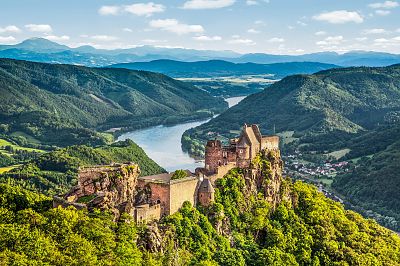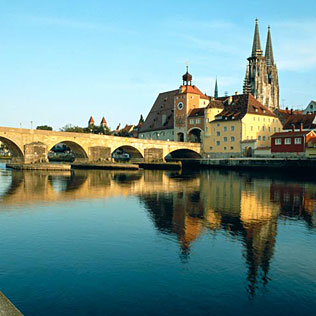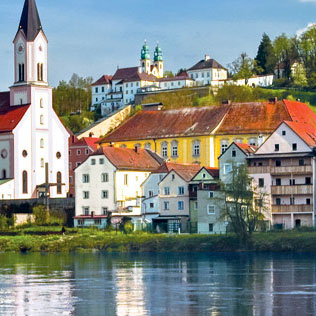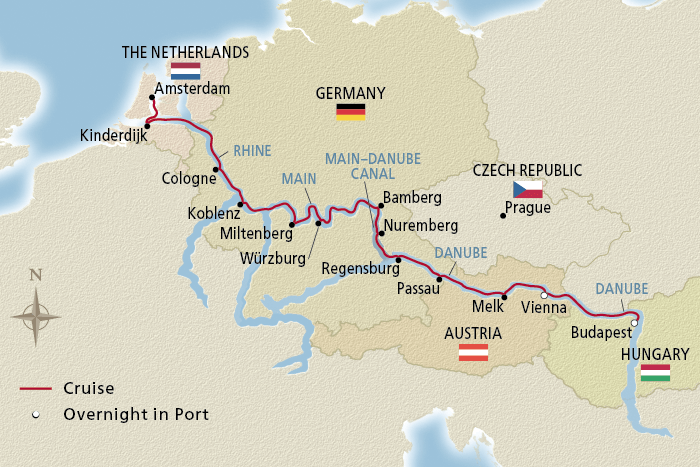Find the River Cruise you’re looking for...
15 Day Viking River Cruise from Amsterdam to Budapest 2026

Grand European Tour
Starting from $4,999River Cruise Description
Absorb the atmosphere of Budapest’s Café Gerbeaud and learn the Viennese waltz. Sample the food and wine of Austria’s Wachau Valley. Admire Rhine Valley vistas from a 900-year-old castle. Our most iconic itinerary traces the Danube, Main and Rhine Rivers between the stunning landscapes of Hungary and the windmill-dotted waterways of Holland, with engaging encounters at every bend.Thanks for your interest!
We'll be in touch soon.Error
I'm sorry, but an error has occurred. Try Again| Departure Date | Ship | Priced From (per person) | |
|---|---|---|---|
| May 3, 2026 | Viking Magni | $5,999 | Call Us! |
| May 6, 2026 | Viking Vidar | $5,999 | Call Us! |
| May 17, 2026 | Viking Baldur | $5,999 | Call Us! |
| May 20, 2026 | Viking Lif | $5,999 | Call Us! |
| May 31, 2026 | Viking Magni | $5,999 | Call Us! |
| Jun 14, 2026 | Viking Baldur | $5,799 | Call Us! |
| Jun 17, 2026 | Viking Vidar | $5,799 | Call Us! |
| Jun 28, 2026 | Viking Magni | $5,799 | Call Us! |
| Jul 1, 2026 | Viking Lif | $5,799 | Call Us! |
| Jul 12, 2026 | Viking Baldur | $5,799 | Call Us! |
| Jul 26, 2026 | Viking Magni | $5,799 | Call Us! |
| Jul 29, 2026 | Viking Vidar | $5,799 | Call Us! |
| Aug 9, 2026 | Viking Baldur | $5,799 | Call Us! |
| Aug 12, 2026 | Viking Lif | $5,799 | Call Us! |
| Aug 23, 2026 | Viking Magni | $5,999 | Call Us! |
| Sep 6, 2026 | Viking Baldur | $5,999 | Call Us! |
| Sep 9, 2026 | Viking Vidar | $5,999 | Call Us! |
| Sep 20, 2026 | Viking Magni | $5,999 | Call Us! |
| Sep 23, 2026 | Viking Lif | $5,999 | Call Us! |
| Oct 4, 2026 | Viking Baldur | $5,799 | Call Us! |
| Oct 18, 2026 | Viking Magni | $5,499 | Call Us! |
| Oct 21, 2026 | Viking Vidar | $5,499 | Call Us! |
| Nov 1, 2026 | Viking Baldur | $5,499 | Call Us! |
| Nov 4, 2026 | Viking Lif | $5,499 | Call Us! |
| Nov 15, 2026 | Viking Magni | $4,999 | Call Us! |
River Cruise Itinerary



Day 1 Amsterdam, The Netherlands
Embark your ship and settle into your stateroom. A city of charming canals, elegant gabled houses, splendid museums and abundant bicycles, the Dutch capital of Amsterdam is a delight to explore. Its patchwork of waterways forms about 90 islands connected by 1,500 bridges. The legacy of the Dutch Golden Age lives on in gilded manses and in the lush paintings of Rembrandt and other Dutch masters that adorn the Rijksmuseum, The Netherlands’ grand repository of art and cultural history. Discovering Amsterdam is a pleasure best pursued on foot; visitors line the tranquil canals and linger over Dutch pancakes, or take a stroopwafel to go.Day 2 Kinderdijk, The Netherlands
Kinderdijk is a village community in the Alblasserwaard province. This corner of South Holland, part of the scenic Waal and Merwede regions, has long been shaped by Rhine Delta waters. Kinderdijk is most known for its 19 remarkably preserved 18th-century windmills. The charming hamlet is located amid low-lying polders, tracts of land reclaimed from the sea by the power of the windmills and enclosed by embankments, or dikes. This legendary place calls to mind the 1865 novel Hans Brinker, in which a heroic boy plugs his finger into a ruptured dike.Day 3 Cologne, Germany
Cologne reveals its Roman heritage in its city layout and the ancient ruins that lie scattered through the town. Cologne’s modern plazas and Hohe Strasse host welcoming shops, enticing restaurants and cologne boutiques. Of note is the city’s 14th-century cathedral, a stunning example of Gothic artistry and a UNESCO World Heritage Site. Having survived Allied bombs during World War II, the cathedral’s imposing twin spires are visible for miles and its stained glass windows fill the interior with brilliant colored light. Its steps lead to a platform with astounding views.Day 4 Koblenz, Germany
Koblenz is a traditional German city, founded more than 2,000 years ago. This former trading settlement rests on a massif of the Middle Rhine Highlands. Its cobblestone streets, wood-beamed houses adorned with flowers, ancient market square and medieval churches recall the fairy-tale Germany of old. At the “German Corner,” a massive equestrian statue of Prince William I observes the lovely riverside scene. The famed Teutonic Knights set up their first base here in 1216. The Romanesque Basilica of St. Castor, Koblenz’s oldest building, dates to 836.Day 5 Scenic Sailing: Main River, Spessart
Journey along one of Germany’s most important waterways today, passing landscapes that embody the country’s scenic beauty and storybook charm. You will sail by quaint riverside villages, undulating farm country and the sylvan forests of the Spessart woodlands. Along the way, you just may lose yourself in the dreamy canvases of half-timbered houses, historic castles and splendid palaces. This is the Germany once ruled by dukes and brought to magical life by the imagination of the Brothers Grimm, who grew up in the town of Hanau and wove fantastic tales from these banks.Day 6 Wurzburg, Germany
Surrounded by Franconian vineyards, Würzburg was heavily damaged during World War II, but has since been completely restored. This prestigious university city is a jewel of baroque architecture. Its most pristine example of pomp and glory is the great Bishops’ Residenz palace, built in 1744 for the prince-bishop; his unwavering support of artists is evidenced by the sweeping staircase and magnificent ceiling frescoes by Tiepolo. Other landmarks include the medieval, statue-lined Old Main Bridge and Marienberg Fortress, originally a Celtic hill fort and later residence of the bishops. The city remains a major wine-making center, hosting Germany’s oldest and largest vineyard.Day 7 Bamberg, Germany
Founded in 902, Bamberg remains a medieval-looking city known for its symphony orchestra and rauchbier, specialty smoked beer. The city’s winding streets are filled with baroque patrician houses and are home to the stunning 11th-century Cathedral of Holy Roman Emperor Heinrich II, housing his tomb and that of Pope Clement II. Bamberg is especially noted for its Altes Rathaus, or Old Town Hall, situated on a twin-arched bridge over the Regnitz River, and for the old bishop’s houses: the 16th-century Alte Hofhaltung (Old Court) and 17th-century Neue Residenz (New Residence).Day 8 Nuremberg, Germany
The second-largest city in Bavaria, Nuremberg is filled with traditional half-timbered houses and Gothic churches with intricate spires. Although nearly destroyed during World War II, the remaining medieval city walls stretch some three miles and feature original gateways and 80 original watchtowers. Nuremberg is well known historically for its metal and toy craftsmanship. But it is infamous for its role in World War II, first as the site of Zeppelin Field’s Nazi rallies and later as the site of the war crimes trials at the Palace of Justice that captured the attention of a generation.Day 9 Regensburg, Germany
Having escaped major damage during World War II, the picturesque town of Regensburg is one of Europe’s best-preserved medieval cities, the oldest city along the Danube and a UNESCO World Heritage Site. The Old Stone Bridge, constructed in the 12th century, is a masterpiece of medieval engineering with its 16 arches. St. Peter’s Cathedral is widely considered Bavaria’s best Gothic architectural work. The Old Town’s Neupfarrplatz square is a cross section of history—it was once a thriving Jewish quarter, a bustling marketplace and the site of Nazi book burnings.Day 10 Passau, Germany
Founded by the Celts over 2,000 years ago, Passau is one of Bavaria’s oldest cities. Known as the “City of Three Rivers,” it rests at the confluence of the Inn, Ilz and Danube rivers. The city has long enjoyed its strategic position and grew to great economic and political power because of it. The legacy of its past prosperity lives on in graceful arcades, colorful houses with rococo facades and the glorious baroque St. Stephen’s Cathedral, home to one of Europe’s largest pipe organs. Passau is also where two nations meet; it is here that the German-Austrian border begins.Day 11 Melk, Austria
Set amid an important wine-growing region of picturesque villages and fairy-tale castles, the charming city of Melk lies at the base of the Wachau Valley. An imposing 900-year-old Benedictine abbey, a stunning example of baroque architecture, overlooks the town from its dramatic hilltop location. This architectural treasure has 365 windows, one for each day of the year, and the views from its expansive balcony are stunning. Its beautiful library houses priceless medieval manuscripts and marvelous frescoes by Paul Troger, and its meticulously kept grounds are inviting and picturesque.Day 12 Vienna, Austria
Renowned as the “City of Waltzes,” Austria’s capital city of Vienna is Europe’s center of classical music. Strauss and Mozart composed many of their finest pieces here. Vienna’s musical history is matched by the elegant, graceful architecture that lines the Ringstrasse, the wide boulevard encircling the Inner City. Baroque, neo-Renaissance, Gothic-Romanesque and other splendidly styled structures, from the Hofburg Palace to the Vienna State Opera, take the breath away with their grand facades. Vienna has a more intimate side too: inviting footpaths lead through green parks and its famed Viennese cafés sweeten any stay with coffee and the city’s delectable Sachertorte.Day 13 Vienna, Austria
In Vienna, coffee is at once an art and a long-embraced tradition that has changed the face of one of Europe’s most beloved cities. UNESCO includes the Viennese coffeehouse culture on its list of Intangible Cultural Heritages, describing the establishments as places “where time and space are consumed, but only the coffee is found on the bill.” It is considered one of life’s simple pleasures to while away an afternoon over an Einspänner coffee and a delectable pastry.Day 14 Budapest, Hungary
Riverside beauty and a vibrant cultural scene blend together in Budapest to form one of Europe’s most rewarding cities. Hungary’s enchanting capital straddles the banks of the Danube, with traditional hillside Buda on one side and modern Pest on the other. By day, astounding art nouveau buildings, stalwart castles and glittering palaces set the stage for awe-inspiring strolls and long soaks in thermal spas. By night, a nostalgic glow settles in as the city’s lights dance on Danube waters, the Chain Bridge uniting it all as a dramatic centerpiece.Day 15 Budapest, Hungary
Budapest’s old town is a fascinating medieval patchwork of narrow streets and colorful houses. In the Castle District, the Matthias Church soars in gleaming Gothic glory. Adjacent, the expansive wall and seven turrets of Fisherman’s Bastion overlook the Danube, the graceful Chain Bridge and the Pest side of the river. The centerpiece of the district is the sprawling Buda Castle. Constructed in the 13th century and expanded to its current baroque splendor in the 18th century, this edifice was home to Hungary’s kings for almost 700 years. After breakfast, disembark your ship and journey home.Having trouble deciding which cruise is right for you?







